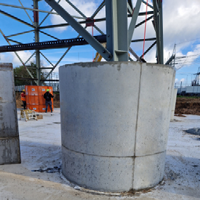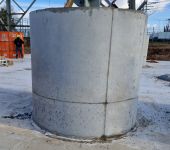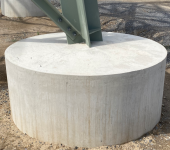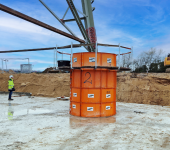Foundations for hybrid pylons for the Ultranet grid expansion project
The full-service provider for transmission line construction relies on the PASCHAL LOGO.3 solution for the formwork of the foundations. Special circular formwork was ordered for the foundation heads that hold the electricity pylons in placeULTRANET is an energy transition project to drive forward the expansion of the electricity infrastructure in Germany. New high-voltage direct-current transmission lines are to transport electricity from northern Germany to the south with low losses. The transmission grid operator TransnetBW commissioned LTB Leitungsbau with the construction of 46 hybrid pylons as part of the structural realisation of ULTRANET. These hybrid pylons can transport both direct and alternating current lines. The full-service provider for transmission line construction relies on the PASCHAL LOGO.3 solution for the formwork of the foundations. Special circular formwork was ordered for the foundation heads that hold the electricity pylons in place.
In order to drive forward the energy transition, the share of renewable energies in the electricity sector is to be increased. The ULTRANET grid expansion project is currently being realised in order to transport the 'green' electricity produced in the northern federal states to the southern federal states. ULTRANET is an approximately 340-kilometre-long direct-current connection of the transmission grid operators TransnetBW and Amprion in existing routes and extends from Osterath in North Rhine-Westphalia to Philippsburg in Baden-Württemberg. TransnetBW is responsible for the approximately 42-kilometre-long section B1 between Mannheim-Wallstadt and the Philippsburg grid connection point. The project in this section will be implemented as a replacement or parallel new construction on half of the route, and as an extension to existing lines on the other half. TransnetBW has commissioned LTB Leitungsbau with the replacement and parallel new construction of the hybrid pylons in the 21 km section between Mannheim-Wallstadt and the Neurott substation.
A total of 34 foundation plates and 184 foundation heads are required for the 46 hybrid pylons on this route. This means that each pylon is firmly anchored in the four heads. LOGO.3 formwork from PASCHAL was used for the foundation forming; special circular formwork was produced for the round foundation heads. The formwork work began in October 2023 and will continue until the beginning of 2025.
Special circular formwork for the foundation heads: maximum flexibility with three panel elements of different heights
LTB Leitungsbau had already had customised circular formwork by PASCHAL produced for previous transmission line construction projects. René Wolf, civil engineering team leader at LTB Leitungsbau: 'We have only had good experiences in the past and therefore decided to rely on formwork from PASCHAL for this transmission line construction project, too.' The new special circular formwork was commissioned because the ULTRANET project required a larger diameter of the foundation heads for the pylons. Previously, diameters of 90 cm to 1.10 metres were sufficient; for the new hybrid pylons, concrete heads with a diameter of between 130 cm and 210 cm were required. The special formwork with a diameter of 210 cm were ordered specially and manufactured by PASCHAL for LTB.
LTB Leitungsbau ordered two sets of circular column formwork with panel elements in three different heights: 1.50 metres high, 60 cm high and 30 cm high. Two half shells or four quarter shells are put together to form the round shape. 'With these three panel elements of different heights – two lower elements and one higher – we can form all the foundation heads at a height of up to three metres that we need for this project – and future ones, too. This gives us maximum flexibility,' confirms team leader René Wolf. The height varies because the foundations have to be at different depths, depending on how uneven the terrain is.
After completion, only the top 40 centimetres of the heads remain visible. The corner posts of the pylons are set in concrete in a round foundation to increase the collision protection against farmers' equipment. Mowers and threshers are much less likely to get stuck on the round concrete heads and therefore do not cause any major damage in the event of a collision.
Strong support for the 70-metre-high hybrid electricity pylons
Two formwork sets of 8 panel elements are sufficient to form the foundation heads for two pylons in parallel. The heads stand on a foundation slab, for which LOGO.3 formwork is used. 'LOGO.3 is actually our wall formwork, but it can also be used for creating foundations,' explains formwork consultant Ralph Voigt, who is responsible for the project at PASCHAL. A total of 144 square metres of LOGO.3 formwork are currently in use. A 1.35 m-high panel element is used to form the 11.80 x 11.80 metre and 70 cm-thick foundation slab. The four corner posts of the pylon are then anchored in the slab.
Ralph Voigt explains the procedure on site: 'After the excavation pit has been dug, the steel structure is assembled and aligned in line and level; then the reinforcement work follows before the formwork is carried out. The LTB Leitungsbau employees then install the pylon and pull the transmission lines.' An impassable or sloping terrain naturally makes foundation construction more difficult. Ralph Voigt explains further: 'Sometimes it is not even possible to produce a single foundation slab for a pylon. In this case – on the section between Mannheim-Wallstadt and Neurott – it was flat enough to produce a single plate onto which all four feet of the pylon are then anchored. Nevertheless, the logistics of a project like this are always a particular challenge for the construction workers.'
Challenging logistics: On the 'digger mats' to the site of the pylons
Although the terrain in Baden-Württemberg – where the existing and new routes run – is not as impassable as in other projects, a construction road still has to be laid for each new pylon – in construction worker jargon, these are referred to as 'digger mats', i.e. when steel plates are laid across the fields for the heavy vehicles. These routes can be used, for example, to transport a construction site crane, digger, telescopic handler and other heavy equipment to reach the individual sites in order to construct the pylons and attach the additional transmission lines.
The entire route for the ULTRANET project is due to be completed by the end of 2026 and will then supply southern Germany with electricity. ULTRANET is then to be extended to Emden on the North Sea coast by 2027.








